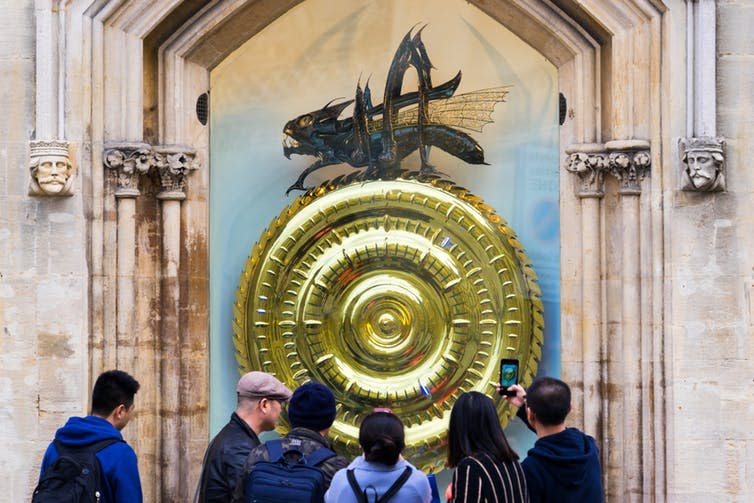Why a 10,000-year clock is being built under a mountain – and why 10,000 years is too long

Construction is underway on a “10,000 year clock”. This is a clock that will have a year hand, a century hand, and a cuckoo that comes out every 1,000 years. The American inventor Danny Hillis wrote about the idea in 1995, and, thanks to a US$42m investment from Amazon CEO Jeff Bezos, the clock is now being installed inside a Texas mountain. The aim of building a clock designed to work for 10 millennia, Bezos says, is to encourage long-term thinking.
The striking thing about a 10,000 year clock is that it’s measuring a very long time, rather than a very short time. We’re getting better at measuring short bits of time – London has been home to a “caesium fountain” atomic clock since 1955, which set new standards for precision timekeeping. In 2013 “optical lattice clocks” were 100 times more accurate than caesium fountains, and experiments continue to improve on this.
The 10,000 year clock, meanwhile, will potentially be the world’s most inaccurate clock. To ensure accuracy, the clock will recalibrate at noon each day, so, if all goes well it can be at most 12 hours out. But, as Lewis Carroll pointed out, a stopped clock is right twice a day. If this clock stops it will be only be right once every 1,000 years. Is such monumental imprecision a bad thing?
What is a clock for, anyway?
How useful clocks are depends on what they are used for. Clocks have become more precise, for example, because activity has needed to be coordinated more precisely.
Think of the marine chronometer, a portable timepiece invented in 1761 by John Harrison, which allowed sailors to calculate their location at sea more accurately. Think of Greenwich Mean Time, which was adopted across Great Britain in 1847, to help people catch trains. Think of the wristwatch, which was used in World War I to coordinate infantry advances with artillery barrages. More recently, GPS uses the time kept by caesium fountains to allow your sat nav to help you navigate your way across the country and have the voice of Brian Blessed congratulate you on successfully reaching your destination.
In a little over 10,000 years, the ghostly voice of Jeff Bezos may well congratulate an intrigued audience on witnessing the 10th cuckoo appear out of his clock. But there doesn’t seem to be a practical purpose served by a 500ft tall mechanical clock dug into the Sierra Diablo mountain range. It is roughly as useful stopped as it is ticking.
But this misses the point. Clocks aren’t just for the coordination of activity, they are often symbolic. Clocks are often used as retirement presents, jewellery and public art. John Taylor’s Chronophage – or “time eater” – is an artwork in Cambridge that’s been reminding the public of their time being ravenously eaten since 2008. Similarly, the 10,000 year clock is primarily a symbol, rather than a timepiece. Its aim is to get us to think about things beyond what’s currently dominating the news agenda.

The 10,000 year clock is a symbol of the Long Now foundation – both aim to foster long-term thinking and responsibility. This is a laudable goal. It is good to ensure that companies don’t prioritise quarterly profits over the sustainability of their businesses. It’s good when governments don’t prioritise re-election over public health issues or the environment. It’s good to ensure that one’s pension provides security in one’s retirement, even if it is many decades away.
In the long run we’re all dead
I’m sceptical, however, that “long-term” thinking is what we really want. As the late John Maynard Keynes pointed out in 1923: “In the long run we are all dead.” Extending our thinking from weeks or months to decades or centuries would be a good thing, but once we start thinking in millennia, we stretch ourselves too far. Corpus Christi college, Cambridge, home of the Chronophage, does a perfectly decent job of reminding its students to think about decades and centuries, rather than weeks and months, having been there since 1352. But this is all “medium-term”; the college isn’t old enough to have witnessed its first cuckoo from a 10,000 year clock. Neither is the British monarchy, let alone the United Kingdom.
Percy Shelley’s poem Ozymandias describes a traveller coming across the broken remains of a statue of Ozymandias (aka the Egyptian pharaoh Ramses II, 1303-1213BC), inscribed with the words “LOOK ON MY WORKS, YE MIGHTY, AND DESPAIR!”. Discussing this poem, the philosopher Christopher Bennett asks:
No doubt at the time we strive and strive to do things that we can feel proud of; but in the scheme of things, how important can anything we do really be, when even the achievements of Ozymandias, ‘king of kings’, will one day be reduced to dust?
This is my worry with “long-term thinking”: such thinking risks removing us from the contexts (our life plan, our society, our civilisation) in which things matter to us. Indeed, it removes us from contexts in which talk of “mattering” makes sense at all. Another philosopher, Thomas Nagel, cautioned against losing touch with the human scales on which our actions, plans and lives make sense: “To see myself objectively as a small, contingent, and exceedingly temporary organic bubble in the universal soup produces an attitude approaching indifference.”
If we think on a 10,000 year scale, what do railways, or pension schemes, or countries matter? The result is paralysis, rather than responsibility. Much better, then, to stick to the medium-term.
This article was originally published on The Conversation. Read the original article.

Dr Graeme A Forbes is a Lecturer in Philosophy at the University of Kent, and a Senior Associate of the Centre for Philosophy of Time, Milan.

 Yahoo News
Yahoo News 